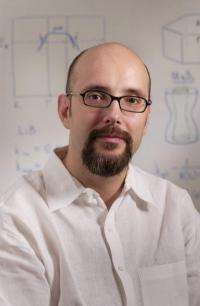Topological insulators: Researchers map path to quantum electronic devices

A team of Duke University engineers has created a master "ingredient list" describing the properties of more than 2,000 compounds that might be combined to create the next generation of quantum electronics devices.
The goal is topological insulators (TI), man-made crystals that are able to conduct electrical current on their surfaces, while acting as insulators throughout the interior of the crystal. Discovering TIs has become of great interest to scientists, but because of the lack of a rational blueprint for creating them, researchers have had to rely on trial-and-error approaches, with limited success to date.
Because of their unique properties, TIs can be created that conduct electricity more efficiently while also being much smaller that conventional wires or devices. They are ideal candidates to become quantum electronics devices, the Duke researchers said.
The "key" developed by the Duke investigators is a mathematical formulation that unlocks the data stored in a database of potential TI ingredients. It provides specific recipes for searching for TIs with the desired properties.
In November, Stefano Curtarolo, professor of mechanical engineering and materials sciences and physics at Duke's Pratt School of Engineering and founder of the Duke's Center for Materials Genomics, and colleagues reported the establishment of a materials genome repository which allows scientists to stop using trial-and-error methods in the search for efficient alloys.
The project developed by the Duke engineers covers thousands of compounds, and provides detailed recipes for creating the most efficient combinations for a particular purpose, much like hardware stores mix different colors of paint to achieve the desired result. The project is the keystone of the newly formed Duke's Center for Materials Genomics.
"While extremely helpful and important, a database is intrinsically a sterile repository of information, without a soul and without life. We need to find the materials' 'genes,'" said Curtarolo. "We have developed what we call the 'topological descriptor,' that when applied to the database can provide the directions for producing crystals with desired properties."
While developing the key to this database, the team also discovered a new class of systems that could not have been anticipated without such a "genetic" approach.
The Duke research was reported online in the journal Nature Materials. The work was supported by the Office of Navy Research and the National Science Foundation.
The new descriptor developed by the Duke team basically can determine status of any specific combination of element under investigation. On one end of the spectrum, Curtarolo explained, is "fragile."
"We can rule those combinations out because, what good is a new type of crystal if it would be too difficult to grow, or if grown, would not likely survive?" Curtarolo said. A second group of combinations would be a middle group termed "feasible."
But what excites Curtarolo most are those combinations found to be "robust." These crystals are stable and can be easily and efficiently produced. Just as importantly, these crystals can be grown in different directions,which gives them the advantage of tailored electrical properties by simple growth processes.
While TIs are currently in the experimental stage, Curtarolo believes that with this new tool, scientists should have a powerful framework for engineering a wide variety of them.
More information: "A Search Model for Topological Insulators with High-Throughput Robustness Descriptors," Kesong Yang, et. al., Nature Materials, DOI: 10.1038/NMAT3332
Journal information: Nature Materials
Provided by Duke University



















